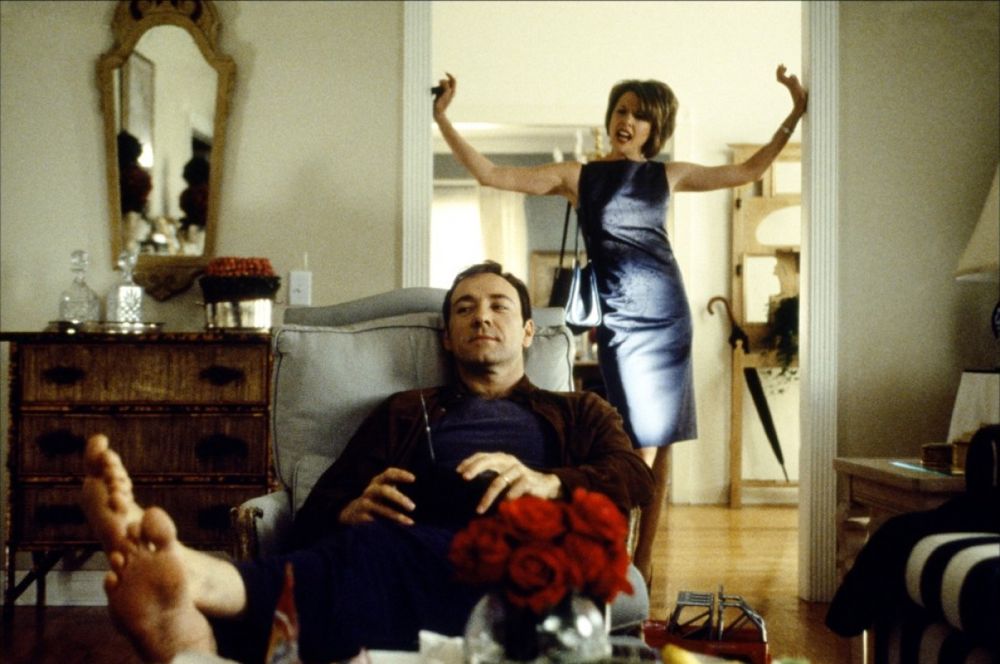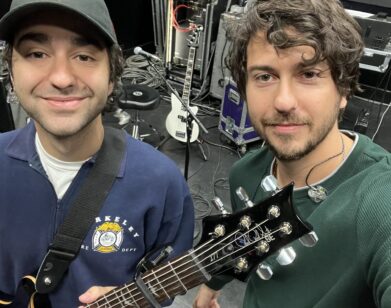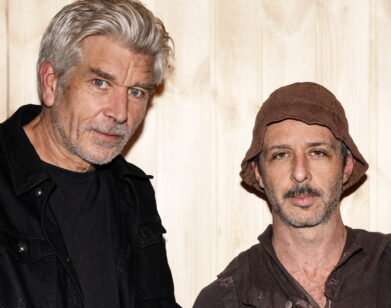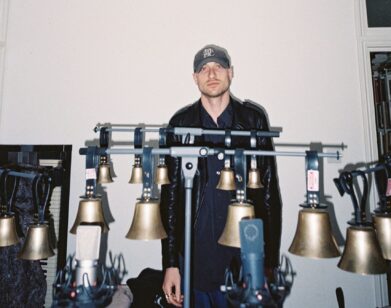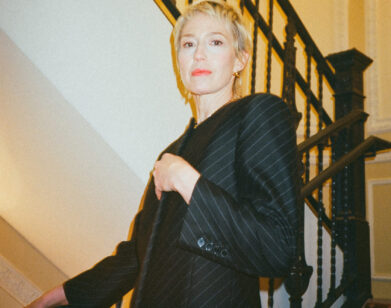Julie Weiss’ Magnificent Obsession
Disguised behind every great moment in film, there is a process. This process varies in scope depending on the project and goes unnoticed more often than not by moviegoers, but the third and final installation of “Persol Magnificent Obsessions: 30 stories of craftsmanship in film” invites us to examine 10 stories that highlight those whose impeccable, detail-oriented workmanship has greatly impacted the film industry. Among the exhibit’s 30 honorees is Julie Weiss, the costume designer behind iconic films including Frida, Fear and Loathing in Las Vegas, Steel Magnolias, and American Beauty.
Before the interview even begins inside her NoMad Hotel suite, Weiss opens a book lying on a coffee table titled Persol Magnificent Obsessions, and searches for a chapter dedicated to her work from the film, Frida. The page she turns to resembles a scratch sheet of paper used to solve algebra equations, carefully calculated and reworked out until the right equation is found— in this case, her designs for Salma Hayek’s character. “That’s how I always sketch,” she explains.
LAUREN LIEB: How did you become involved in the exhibit? Did you choose what to include in the exhibit from your films?
JULIE WEISS: [Curator] Holly Gilliam approached me for the exhibit. I’ve tried to do many different types of stories. I try to work in theater, film, television, and I’ll also be designing an opera. I go where the story is. I believe that if I have anything to contribute, it’s from the opportunity of circumstance. Which is, when you’re growing up, if for some reason you’re on the outside of the circle, you do get to watch. As you watch, you realize how much you miss. Because if you’re looking at yourself, you cease to see those around you and that detail. Whether or not it’s false in their eyes, whether it’s compensatory, or whether it’s true. You see where their priorities are—if they have time to stand in front of that mirror or if they choose to copy someone else. You see those who are ignored that ultimately will be discovered or will never be discovered. We’re very busy and now optically, we’re swamped. We miss a great deal. Sometimes I think that soon there will be screen lines on the sides of our faces because we are so used to seeing within a frame—I would like to smash those frames. I think that the honor of being a costume designer is your allowance to dress those who other people would walk by. I’m allowed to bring them forward and have their predicament examined either with great sadness or great celebration.
LIEB: I’m not sure if you’ve seen it, but what you’re saying reminds me of a recent video I watched of Dustin Hoffman talking about his character in Tootsie and the process of being transformed into a woman for that role. It had to do with him not considering the film a comedy after he realized all the great people he missed out on in life because he never gave them a chance based on their appearance….
WEISS: Well that’s quite an honor—he’s a great actor. There’s something quite glorious about being a costume designer, and that is you can bring forward other people—people whom you might have forgotten and that you’re really respectful of because it was too hard to look at them, and because they weren’t part of what was popular at that moment. We can be quite cruel in what we assume about people by the way that they dress. I would hope that the scripts that I’m allowed to be a part of would diminish that cruelty.
LIEB: You started off designing costumes for Broadway shows, and then transitioned into film. Is that transition similar to if you were an actor and had to lower your vocal projection? In film, do you have to create less flamboyant costumes?
WEISS: It depends on the story that you have. The process is different because you have rehearsal time in [theater], and in film you don’t have that rehearsal time. Hopefully you get the opportunity to elevate through these visual tools, and that’s what a costume is—it is a tool for that actor. You cannot work alone, nor do you want to. You can’t sneak up on stage or stand outside a film saying, “Did you like the third one?” You have to be able to give it away. Our field, whether it’s in theater, film, television, or opera—it’s a company. We are working with the people: the producers, directors, actors, production designers, lighting designers, and cinematographers… but absolutely not in the order that I said this. In the end, it no longer belongs to us; it should never belong to us. From the moment you start, you are giving it away to the audience. What you hope is that you are throwing out all these ping-pong balls, like a carnival. You hope that as they land in the seats, that they will connect with another person’s memory or an experience. When that film or play is over, what makes those people stand up together and go, “Ah”? What makes that one moment of quiet when it’s over? The grace of being a costume designer is that you’re a part of [it]. Yes, there have been costumes that were never seen, and I would think they were some of my best work, but they didn’t belong. That’s when you have to realize that the process of being a costume designer is very exciting, as is the moment you give it away. Now if I could believe what I just said, I would really be a terrific costume designer. But I’m still putting dirt on Annette Benning’s apron and every night I dream about it in American Beauty. [laughs]
When I mention the company of people, you need people who will make the clothes, find the clothes, and find the fabrics. As you sit and watch a performance, you can also sit quietly in front of a cutting table and watch those scissors glide. Those are great moments. The not-so-great ones is when you sneak in and you think, “Maybe it should open in the front,” and your cutter/fitter makes this beautiful costume and you decide to have the actor wear it backwards. Sometimes that doesn’t go over so well.
Sometimes my inspirations come a little bit late, and that’s not so good either. You hope that when it all comes together, people will remember what they saw. Because they’re not going to remember just the gold sandal with the blue purse framing the knees and the great navy blue ruffle—they are going to remember what was happening in that scene. When they remember that, they remember the clothes—the costumes.
LIEB: How much do you consider the actors when you design the costumes? Like for Salma Hayek in Frida?
WEISS: She’s everything, or you might as well put a brassière on a tree. You are nothing without the actor. The actor has to turn that moment into the believability that she has put that costume on in the morning. Now Frida is a very interesting combination, because Frida will get dressed up, she will wear traditional garb in a non-traditional way. She had her own sense of style, and she celebrated herself. In her darkness, you could see that in her dress when she cut her hair off and wore a suit—we were shocked. But we understood, because the great thing about doing something like Frida is that you had proof within both her words and paintings. Your tools were there. You watched Salma become Frida, and you watched Salma as Frida. That’s nice.
LIEB: Who’s been your favorite character to dress? That’s probably a difficult question to answer.
WEISS: What makes it difficult is that it’s not the character to dress, it’s the moment when you see things that work. You see how the actors wear things. When you talk about this, I’m hoping you include it because it is a range, because you see someone like Robert Duvall who uses a costume so well—or Marlon Brando, Bette Davis, and Billy Bob Thornton. You see somebody like Diane Lane play a character and then the woman who she is playing comes to visit the set and you go, “Look at that.” You see Bruce Willis get dressed in this spacesuit with an old Speedo bathing cap. You’ve taken away his dignity, and he plays it as a loss! Those are wonderful moments for a costume designer. You’re taught to watch that mergence between actor and character in that fitting. You see it happen with some of the great actors, and that’s why you’re there—you’re there to be part of.
LIEB: The exhibition deals with obsessive craftsmanship and perfection. What’s your idea of perfection, or does that even exist to you?
WEISS: I’m still working on all the things that I’ve done. I can’t stop, and I’d like to think of myself as a non-obsessive personality, but if I had scissors, I would really like the back of these drapes. [gestures towards the hotel room’s beige curtains] I know I could use them in my next project, but I shall not cut.
LIEB: Where’s the most random place you’ve found inspiration?
WEISS: I don’t think of that as random. What you see is what you use. It’s this immense storage area of other people’s memories. When it comes into view in a way that you can use them, you pull them forward as fast as you can before you forget. Unfortunately, usually it’s on someone else’s body, so you do have to try to convince them it’s better off being seen by more people, and thus the process begins. But your clothes come from everywhere, and your costumes come from everywhere. They’re made from fabrics and other people’s moments. By clothing that was left behind and clothing of the moment of great style.
LIEB: Is there a strange material that you’ve incorporated into a costume you’ve designed?
WEISS: It’s in every one of them. It depends on the character. Whether it’s a pair of old socks, a piece of paper, a medical brace, the most beautiful couture jacket, a moment of disobedience, or a moment of acceptance. But when they all come together—it has to work and only be a level of distraction when it’s appropriate, and that’s so hard.
LIEB: How do you approach designing costumes for different genres? I mean, you’ve done horror, comedy… you’ve done everything, really. Is it the same for each film?
WEISS: Yes, you read that script. I would hope that I mentioned this before—the author and playwright—because you’re nothing without the written page. If I were to start the way that I work, if I could open up and describe the first thing, I would say, “You cannot begin without the written page—and then you start.” As long as we are human beings, I approach costume design the same way. A shoulder pad is not a moment of disobedience. The moment of disobedience comes before you decide how to dress them in whatever period they are or the moment of obedience.
“PERSOL MAGNIFICENT OBSESSIONS” IS ON DISPLAY AT THE MUSEUM OF THE MOVING IMAGE IN NEW YORK THROUGH NOVEMBER 10.

